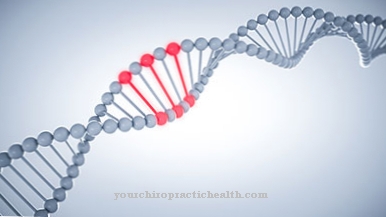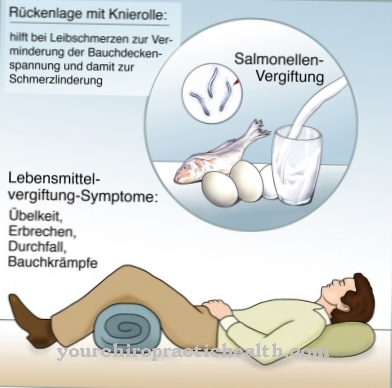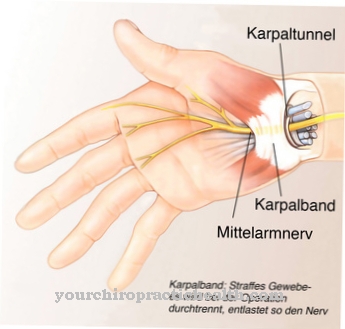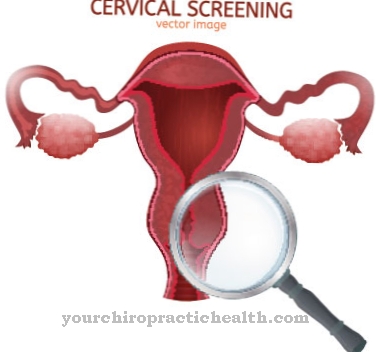The Maroteaux-Lamy Syndrome belongs to the mucopolysaccharidoses, which comprise various lysosomal storage diseases. The syndrome is due to a genetic mutation that results in insufficient enzyme activity and leads to dermatosulfate deposits. The therapy consists mainly of enzyme replacement therapies.
What is Maroteaux-Lamy Syndrome?

© imaginuma - stock.adobe.com
The mucopolysaccharidoses are an independent group of diseases that contain lysosomal storage diseases. Lysosomal storage diseases exist around the corner. All of them are genetically determined metabolic diseases that are caused by malfunctioning of the lysosome. One of these diseases is the so-called Maroteaux-Lamy Syndrome. The innate metabolic disorder leads to a storage of dermatinsulphates.
The terms are used as synonyms Mucopolysaccharidosis type VI, Aryl sulfatase B deficiency, ARSB deficiency and ASB deficiency such as N-acetylgalactosamine-4-sulfatase deficiency. The disease was first described in 1963. The Parisian human geneticists and paediatricians P. Maroteaux and M. Lamy are considered to be the first to describe it.
The prevalence of the disease is between one and nine affected people in 100,000 people. Familial accumulation was observed in the cases documented so far. The syndrome is inherited in an autosomal recessive manner. A genetic mutation is considered to be the cause of the disease.
causes
The Maroteaux-Lamy syndrome is due to a mostly hereditary mutation. The causative mutations have now been localized to the ARSB gene. Mutations at the gene locus 5q13 to 5q14.1 are said to be able to cause the complex of symptoms. The genes located there code within the DNA for a specific protein.
A mutation of the genes is said to result in abnormal activity of the mutated aryl sulfatase B, also known as ASB or N-acetylgalactosamine-4-sulfatase. The activity of the substance is reduced as part of the mutation. Because of this reduction, there are disruptions in the breakdown of substances such as chondroitin sulfate and dermatan sulfate. Since the substances are no longer sufficiently broken down due to the causal mutation, the body stores residues of the substances.
The typical symptoms of Maroteaux-Lamy syndrome are a result of this storage. It is not yet known whether genetic factors as well as external influences play a role in the development of the mutation. This can be assumed, at least for new mutations.
Symptoms, ailments & signs
Patients with Maroteaux-Lamy syndrome suffer from a complex of clinically characteristic criteria. One of the most important symptoms is a disproportionately acting short stature, which is characterized by a short trunk. The disproportionality of the patient is associated with a coarsened face that is reminiscent of the symptoms of Hurler's disease.
In most cases, the patient's cornea is cloudy. In addition, there may be hepatosplenomegals, hernias or contractures of the joints. The patients' heart valves become increasingly thickened due to the deposits. In addition, there may be skeletal dysplasia that is similar to that of patients with dysostosis multiplex.
Both the clinical picture and the course of the syndrome are considered to be variable and individual. In addition to slow processes, fast processes were also documented. If the first symptoms manifest themselves immediately after birth, this phenomenon speaks for a rather rapid course.
This is especially true for an increase in glycosaminoglycan in the urine, for severe dysostosis multiplex and manifest short stature. Affected people with a slow course usually show the first symptoms much later. The GAG increase is much lower and the dysostosis multiplex is much milder.
Diagnosis & course of disease
Maroteaux-Lamy syndrome does not necessarily have to manifest itself immediately after birth and is in many cases only diagnosed later, when the first symptoms appear. The diagnosis is based on the clinically typical criteria of the disease and is therefore based primarily on a significantly reduced ASB activity, which can be traced on cultured fibroblasts and leukocytes.
On the other hand, normal activity exists in relation to other sulfatases. As part of the diagnostics, the doctor also provides evidence of the increased amount of dermatan sulfate excreted in the urine. In the differential diagnosis, Maroteaux-Lamy syndrome must be differentiated from multiple sulfatase deficiency and other forms of mucopolysaccharidosis. Sialidosis and mucolipidosis are also diseases that are relevant for differential diagnosis. The patient's prognosis varies from case to case and depends primarily on the age of onset and the severity of the first symptoms.
Complications
First and foremost, the Maroteaux-Lamy syndrome leads to a short stature in the patient. Children in particular can suffer from bullying and teasing at a young age and develop psychological problems or depression as a result. As a rule, further growth of the patient does not take place proportionally and various complaints and malformations occur, which also occur in the face.
Furthermore, the heart valves are damaged and misplaced by the Maroteaux-Lamy syndrome, so that there are complaints or limitations in the heart. In some cases, it can also reduce the patient's life expectancy, which can lead to cardiac death. A causal treatment of this syndrome is not possible. For this reason, the main aim of treatment is to limit and combat the symptoms so that the person affected can lead an ordinary life.
Psychological treatment may also be necessary. There are no particular complications, although not all complaints can be completely limited. As a rule, life expectancy is also not reduced by Maroteaux-Lamy syndrome if there are no symptoms of the heart.
When should you go to the doctor?
If a growing child shows signs of disturbances or changes in the physical development process, a doctor must be consulted. If the child is clearly short stature or has a malformation of the skeletal system, he needs medical help. If there are abnormalities or peculiarities of the body shape in direct comparison with children of the same age, a doctor should be consulted to clarify the symptoms. Disorders of movement sequences or general motor skills must be presented to a doctor. A doctor will also be needed if the cornea is cloudy or eyesight is reduced. Irregular heart rhythms indicate a health problem, which must be examined in various medical tests.
In most cases, the first abnormalities of the disease can be recognized immediately after birth due to changes in the skeletal system. Since the infants are extensively examined by the physician present after they are born, there is no need for the parents to act. If symptoms such as vomiting or pain occur in the first few weeks or months of life, a doctor must be consulted. If the child cries and cries continuously, this is a sign of an irregularity that needs to be clarified. In the event of breathlessness or an acute health condition, an emergency service must be alerted. Until it arrives, first aid must be provided to ensure the child's survival.
Treatment & Therapy
A causal therapy is not available for patients with Maroteaux-Lamy syndrome in the narrower sense, as the changed enzyme activity of those affected is due to a genetic mutation that could only be remedied by gene therapy. However, with enzyme replacement therapy in the broadest sense, a type of therapy is available that addresses the symptoms of the disease at their source.
In enzyme replacement therapy, patients receive galsulfase in the sense of naglazymes. This enzyme replacement results in a better breakdown of the relevant substances and thus delays the course of the disease. However, the symptoms that have occurred so far cannot be completely reversed. Heart valve thickening may be treated symptomatically and, under certain circumstances, may require surgical replacement of the heart valves.
Acute hernias are treated with taxis. The goal is a reduction that allows the doctor time to find an operative solution. Severe corneal opacities resulting in blindness can possibly be reversed with a corneal transplant. Symptoms such as short stature cannot ultimately be reversed, but often only occur in a mild form with early treatment with an enzyme replacement drug.
You can find your medication here
➔ Medicines for painOutlook & forecast
This rarely occurring disease occurs in a wide range of forms and forms.Thanks to the individual course and the different degrees of Maroteaux-Lamy syndrome or mucopolysaccharidosis type 6, it is usually difficult to give a reliable prognosis for a specific patient.
In general, the prognosis is worse if the first symptoms of Maroteaux-Lamy syndrome show up shortly after birth. This usually speaks for a faster course of the disease.
As a result, it can be said that the age of those affected allows a conclusion about the expected prognosis, as does the point in time at which the first symptoms of Maroteaux-Lamy syndrome appeared. Besides, the outlook for the patient also depends on the quality of the treatment. The time at which enzyme replacement therapy was initiated is often critical.
Enzyme replacement therapy can break down substances like chondroitin sulfate and dermatan sulfate. It thus slows down the course of the disease. The problem, however, is that damage that has already occurred in the organism is usually not reversible. This reduces the quality of life, but can also result in the affected person dying earlier. The course of Maroteaux-Lamy syndrome can be rapid if it occurs early. The patient can also respond well to the medication administered. In this case, the Maroteaux-Lamy syndrome will progress accordingly slowly.
prevention
So far, no external factors are known for the development of Maroteaux-Lamy syndrome. The only preventive measure currently is genetic counseling in family planning.
Aftercare
Since the treatment of Maroteaux-Lamy syndrome is complex and long-term, classic follow-up care is not required. Rather, those affected should concentrate on dealing safely with the disease and building a positive attitude despite the adversity. Relaxation exercises and meditation can also help calm and focus the mind. Since short stature goes hand in hand with a reduction in aesthetics, any inferiority complexes and weak self-esteem should be discussed with a therapist if necessary. This can help to better accept the disease and improve the quality of life in the long term.
You can do that yourself
Self-help options are not available to those affected with Maroteaux-Lamy syndrome. The disease can only be treated symptomatically; there is no causal therapy.
In order to alleviate the symptoms of the disease, those affected depend on the intake of enzymes and various medications. Here, regular and prescribed intake should be ensured. In severe cases, however, surgical interventions on the heart are necessary. In order not to stress the heart unnecessarily, unnecessary exertion should be avoided. This is especially true for sudden or abrupt loads.
If the patient or the parents want to have children again, genetic counseling can be useful in order to prevent the Maroteaux-Lamy syndrome from occurring again. Conversations with close people or friends can often alleviate psychological complaints or depression. Contact with other patients with Maroteaux-Lamy syndrome often has a very positive effect on the disease and can contribute to an exchange of information that can possibly improve the quality of life of the person affected. However, complete cure of the syndrome cannot be achieved.














.jpg)













